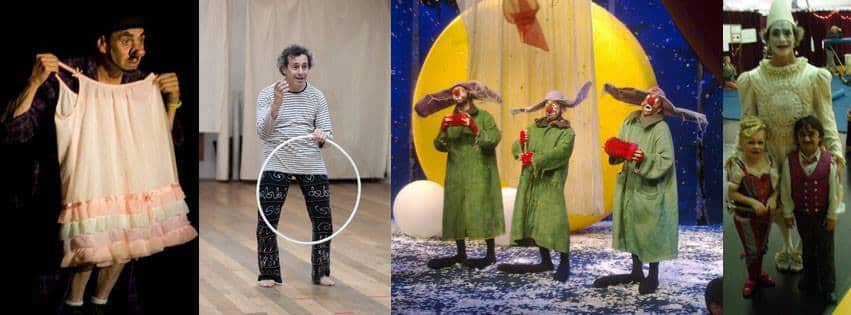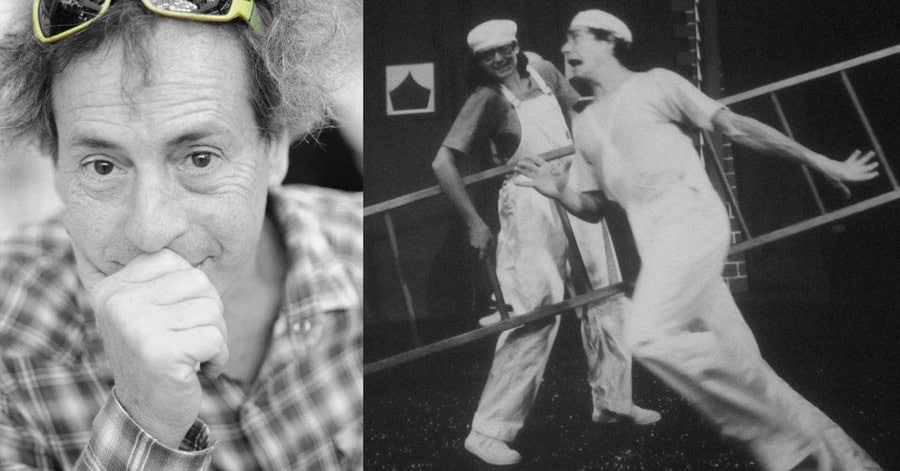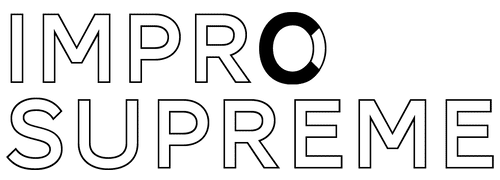There are two types of clown masters:
- Those who want to control you – to be your master.
- Those who want to pass on their mastery – to set you free.
Ira Seidenstein, my mentor, belongs to the second category.
He is a true clown master – first of all a performer of consummate skill and secondly an educator with an exceptional eye for the needs of the individual student.
His work as a clown teacher, coach and creative mentor embodies his own unique career as a clown, from Shakespearian clowning in local pubs as a young physical theatre student to performing in big international productions like Slava’s Snowshow and Cirque du Soleil’s Corteo.
When he teaches clowning, he works much like a ballet master, whose mission it is give you the necessary training, not just for a specific part, but to increase your overall level of competence as a creative stage artist.
Because that is what you need if you are to be a notable clown.

Ira Seidenstein in four of his many guises. From left to right: (1) as ‘Mo’ in Moments; (2) demonstrating The Marcel Marceau Exercise during a workshop in Paris – the hoop in photo belonged to Marceau; (3) in Slava’s Snowshow – the middle clown; (4) as White Clown in Cirque du Soleil – pictured with fellow artists from Kiev, Valentyna & Grigor.
(Much) More Than Just a Clown Teacher
It’s a fact that Ira Seidenstein masters the art of clowning like few other clown teachers. Not only because he is a genuine clown, but because he is so much more than that.
He was a tumbling and comic acrobat, a mime and slapstick comedian, a classical actor, a director and a playwright. He has choreographed over 200 comic sketches and slapstick acts – and portrayed over 75 clown characters.
What else? He trained as a Iyengar yoga teacher and he’s got a PhD in Education. He is also something like a walking encyclopaedia when it comes to knowledge about the history and traditions of clowning, commedia and circus.
You can also count on him if you want invaluable tips for directing and performing Shakespeare. Ira’s second book has about 80 pages dedicated to his (practical) research into what he calls the ‘Missing Link’ – or how to drastically improve the quality of almost any production of Shakespeare.
“
Why is one actor clear and another not? Why are the great actors good? Why does so much Shakespeare sound like gibberish? Why do actors who think they know what they’re doing communicate so poorly?
Ira Seidenstein
Clown Training Not Just for Fun
Ira Seidenstein’s approach to clown training is greatly focused on clarity of communication. If we paraphrase the quote above, we’ll get a good idea of the main questions that have shaped his method:
Why is one clown clear and another not? Why are the great clowns good? Why does so much clown teaching sound like pseudo-philosophical psychobabble? Why do clowns who think they know what they’re doing communicate so poorly?
Look up a dozen random clown teachers and you will find that many (if not most) have a rather limited experience as professional clowns. Which probably explains why a lot of clown training relies on various gimmicks, rather than on profound know-how.
I’ve seen quite a few clown students and performers who thought they were already clowns being rather dismayed in Ira’s workshops. The experience with him was simply too removed from what they were used to: playing fun games and vying to be the most lovable idiot.
These wannabe clowns weren’t prepared to work technically. Sometimes it was just because they had had too little training in basic performance and acting skills. But mostly it seemed to be a question of intellectual immaturity.
They were lost without the guidance of a clown master who told them what they were supposed to do or what they should be like.
“
How to learn more about clowning? The art of clowning? First the physical expression. A clown must be able to dance, mime and fall. I would go first to dance as a discipline for clowns. Technical and expressive & creative.
Clowning is knowledge of gags, routines, techniques. It is a very solid art form itself. It is not a red nose and improvisation, these are simply two tools.
Ira Seidenstein
What Happens in a Clown Workshop…
Ira Seidenstein is an exceptionally pragmatic clown teacher and coach. He is not a clown master who obsesses about what a clown is or should be, nor does he waste your time (or lull you into a daze) by waxing poetic about the clown spirit.
Training the body comes first. Before any of the comic stuff.
I’ve witnessed the very real magic of this simple recipe again and again. Ira is a clown master who coaches workshop participants towards discovery and self-knowledge as stage artists. That is to say: creative discovery and practical self-knowledge.
It’s technical. It’s not therapy or spiritual healing.
Although it may of course have that effect on you, particularly if you’ve never really honoured your own creativity before.
Anything good, funny, interesting that happens in a clown workshop should not depend on the teacher (even though he may have provoked it). It should be reproducible.
Which means that you should be the master of it and know how to do it again, if you so wish. In other words: you need to know the mechanics of it.
The benchmark with Ira is clowning at the highest professional level. The masters of old serving as the primary models. Look at Chaplin, Keaton, Lucille Ball… and many, many more. They knew exactly what they were doing.
Quite like Ira when he’s teaching.
5 Days With Ira Seidenstein
I’ve lost count on how many workshops or courses I’ve done with Ira. Somewhere around thirty.
Here’s what typically happens in a clown workshop with him:
- Day 1 – Most new participants suffer through his basic movement training and are more or less lost in the creative exercises. They are impatient for the clowning. By the time we get there, officially, so to speak, they often struggle because they are either chasing the fun or getting stuck on some idea they have about clowning. All the while the rest of us struggle with our various habits.
- Day 2 – Frustration usually continues. People who don’t have a regular movement practise come back feeling a little sore in the muscles. We repeat everything from the day before. New participants with a bit of clown baggage perhaps try other tricks that have worked for them before. But mostly to no avail. You won’t last long clowning in front of Ira if you don’t use your body.
- Day 3 – The first pennies drop. Some of the new participants will suddenly ‘get it’. It’s plain to see when someone gives in and starts trusting their body. It’s as if a veil is lifted. Whatever they do is suddenly visually clear. It may last only a few seconds. But everyone will have seen it. ‘Maybe this clown master knows what he’s doing, after all’, some seem to be thinking. Returning participants are also having minor or major breakthroughs at this point.
- Day 4 – More pennies drop. Everyone’s usually in the same boat by now. The new ones start appreciating the bending of knees. Returning participants can’t believe they still drop their arms. We all suffer for our art. But we know there’s a method to the madness. Ira tells more stories from his long career. I forgot to mention that he’s been clowning in exercises and during demonstrations for us all along, right from day 1.
- Day 5 – There’s a clear sense of purpose. Everyone’s working, for real. Physically, technically, creatively. On their own and together with others. Ira keeps up the pressure. Increases it. Now he can really assist people in their clowning.
All this to say: five days of clown workshopping like this is just a beginning.
But it’s enough to get familiar with the techniques and principles of The Four Articulations – and that’s probably more to work with than you’d get from most other physical acting or clown workshops.
Entering The World of Clown
A clown master isn’t born out of nothing. Nor is a clown. All we can say for sure is that the art of clowning is based on tradition – knowledge of technique, gags, routines. And that it’s deeply connected to the arts of theatre and storytelling.
How someone enters the world of clown – or how a clown enters into the world – remains something of a mystery.
Ira Seidenstein himself fell into theatre as a young man at the beginning of his university study in Liberal Arts. He discovered his creativity and imagination in a flash of inspiration when taking his first pose as an art model (yes, nude) in a drawing class on campus.
It was during this period that he first perceived the pursuit of clowning as a way to learn more about creating theatre. He felt that a clown had to learn the roles of director, writer, designer, trainer and business person all at once.
Here’s how Ira describes his initiation into the world of clown:
“
I came across an authentic circus master Danny Chapman, who at that time, at 63yrs old, had been in circus 55 years. Finally the day came when I was to be a clown in performance with him.
At his home he gave me one of his costumes and he put on my make up, then stood me away from him and another circus apprentice.
Danny asked me to put on the red nose.
As I did so, I was again (2 years later) hit with a virtual bolt of lightning through my crown. Danny and the apprentice witnessed this and my reaction and fell into hysterical laughing.
I stood still as a statue, but I looked at each of them. As I eyed each, they saw something new and laughed again. With tears in his eyes and still laughing, the old clown Danny told me to take off the nose. He had truly initiated me.
Ira Seidenstein
In a sense, Ira’s whole approach to clown and clowning can be summed up in this transformation from the naked human shape of an art model to putting on the full garb of an old clown master:
- First the body: stillness and feeling.
- Then creativity and imagination.
- Then costume, make-up and clown nose.
- Then maybe – maybe – a clown appears.
- Good. Now what do you want to do?
That last question remains an absolutely crucial one. It ties in directly with Ira’s general definitions of clown and clowning:
“
A clown is someone who does what he wants, when he wants, however he wants, as long as he wants.
Clowning is playing with what you are doing.
Ira Seidenstein
The Final Words From Here
Thank you for reading. I hope by now it’s clear why I consider Ira Seidenstein to be a true clown master.
Let’s remember that even though clowning is not a red nose and improvisation – it still is playful and joyful. If we put in the foundational work, like movement training, mime and classical acting, then we will be able to enjoy clowning more – both on a higher level of detail and a deeper level of artistry.
This admittedly very challenging enjoyment is what I discovered myself when I took my first workshops with Ira. It’s what made me invest so much time in learning and then teaching his method.
Now Listen to the Clown Master Himself
Here’s a video feature on Ira Seidenstein from 2014 – enjoy!
If you want to dig further into Ira’s thoughts on clown training, I recommend starting with these articles on his blog:
- Beyond the Norm in Clown Training
- Teaching Is Learning
- Training Actors, Clowns, Directors – What Works, How and When?
Should you decide to purchase his books, I strongly recommend reading Quantum Theatre: Slapstick to Shakespeare before digging into Clown Secret.


